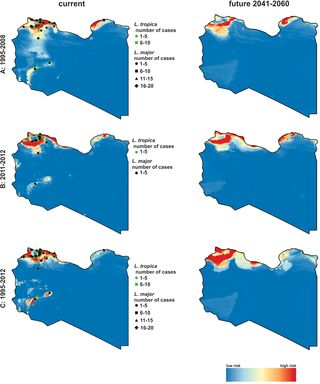PLOS Neglected Tropical Diseases ( IF 3.8 ) Pub Date : 2017-09-07 , DOI: 10.1371/journal.pntd.0005873 Ahmad Amro , Hamida Al-Dwibe , Aisha Gashout , Olga Moskalenko , Marlena Galafin , Omar Hamarsheh , Marcus Frohme , Anja Jaeschke , Gabriele Schönian , Katrin Kuhls

|
Background
Cutaneous leishmaniasis (CL) is a major public health problem in Libya. In this paper, we describe the eco-epidemiological parameters of CL during the armed conflict period from January 2011 till December 2012. Current spatiotemporal distributions of CL cases were explored and projected to the future using a correlative modelling approach. In addition the present results were compared with our previous data obtained for the time period 1995–2008.
Methodology/Principal findings
We investigated 312 CL patients who presented to the Dermatology Department at the Tripoli Central Hospital and came from 81 endemic areas distributed in 10 districts. The patients presented with typical localized lesions which appeared commonly on the face, arms and legs. Molecular identification of parasites by a PCR-RFLP approach targeting the ITS1 region of the rDNA was successful for 81 patients with two causative species identified: L. major and L. tropica comprised 59 (72.8%) and 22 (27.2%) cases, respectively. Around 77.3% of L. tropica CL and 57.7% of L. major CL caused single lesions. Five CL patients among our data set were seropositive for HIV. L. tropica was found mainly in three districts, Murqub (27.3%), Jabal al Gharbi (27.3%) and Misrata (13.7%) while L. major was found in two districts, in Jabal al Gharbi (61%) and Jafara (20.3%). Seasonal occurrence of CL cases showed that most cases (74.2%) admitted to the hospital between November and March, L. major cases from November till January (69.4%), and L. tropica cases mainly in January and February (41%). Two risk factors were identified for the two species; the presence of previously infected household members, and the presence of rodents and sandflies in patient’s neighborhoods. Spatiotemporal projections using correlative distribution models based on current case data and climatic conditions showed that coastal regions have a higher level of risk due to more favourable conditions for the transmitting vectors.
Conclusion
Future projection of CL until 2060 showed a trend of increasing incidence of CL in the north-western part of Libya, a spread along the coastal region and a possible emergence of new endemics in the north-eastern districts of Libya. These results should be considered for control programs to prevent the emergence of new endemic areas taking also into consideration changes in socio-economical factors such as migration, conflicts, urbanization, land use and access to health care.
中文翻译:

利比亚皮肤利什曼病的时空和分子流行病学
背景
皮肤利什曼病(CL)是利比亚的主要公共卫生问题。在本文中,我们描述了2011年1月至2012年12月武装冲突期间CL的生态流行病学参数。使用相关建模方法探讨了CL病例的当前时空分布并将其预测到未来。此外,将目前的结果与我们之前在1995-2008年期间获得的数据进行了比较。
方法/主要发现
我们调查了312位CL患者,这些患者来自的黎波里中央医院皮肤科,来自10个地区的81个地方病区。患者表现出典型的局部病变,通常出现在面部,手臂和腿部。通过针对rDNA的ITS1区域的PCR-RFLP方法对寄生虫进行分子鉴定,已成功对81名患者进行了鉴定,其中发现了两种致病菌:L。大和大号。tropica分别占59(72.8%)和22(27.2%)例。大约77.3%的大号。tropica CL和L的57.7%。重大的CL引起单个病变。我们的数据集中有5名CL患者的HIV血清阳性。大号。tropica被发现主要是在三个区Murqub(27.3%),向al加尔比(27.3%)和米苏拉塔(13.7%),而大号。在Jabal al Gharbi(61%)和Jafara(20.3%)两个地区发现了重大毒药。CL的情况下发生的季节性表现考上十一月至三月之间,医院,大多数情况下(74.2%),大号。主要从十一月案件至1月(69.4%),和大号。热带病例主要发生在一月和二月(41%)。为这两个物种确定了两个危险因素;患者以前有被感染的家庭成员,以及啮齿动物和沙蝇的存在。使用基于当前病例数据和气候条件的相关分布模型进行时空预测表明,沿海地区由于传播媒介的条件更加有利而具有较高的风险水平。
结论
到2060年,对CL的未来预测表明,在利比亚西北部,CL的发病率呈上升趋势,在沿海地区扩散,在利比亚东北部地区可能出现新流行病。应将这些结果用于控制计划,以防止出现新的流行地区,同时还要考虑到社会经济因素的变化,例如移民,冲突,城市化,土地使用和获得医疗服务。



























 京公网安备 11010802027423号
京公网安备 11010802027423号